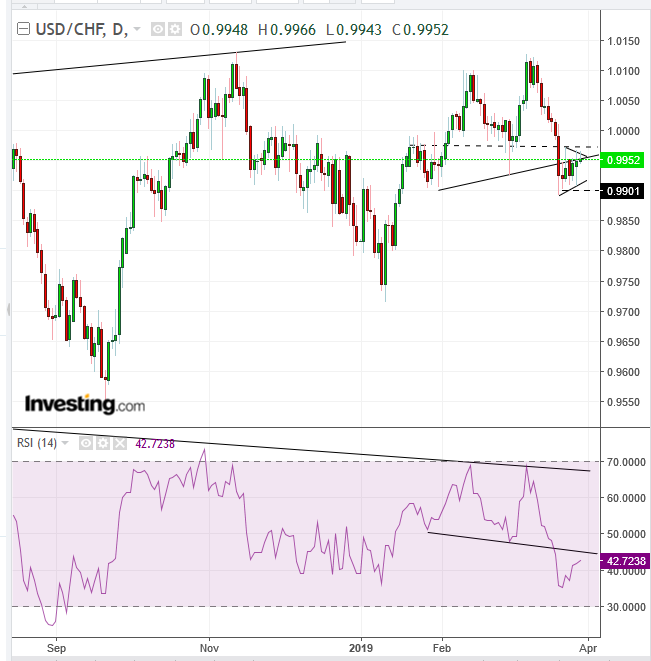Investors are currently trapped in a vicious cycle: they keep rotating out of the risk of stocks, into the safety of bonds, then into the safe-haven yen. In the meantime, traditional havens gold and the Swiss franc—after rallying earlier this month—have lost steam and weakened.
But we expect the Swissy to rise again. In our view, the current decline is part of a pattern in which it is gearing up for another sharp move higher, following its 2% jump earlier in the month.

The dollar-Swissy pair has dropped for seven straight sessions, the most extended retreat for the currency in a very long time. The move completed a double top.
Since then, prices have congested. Traders have been waiting for a signal indicating whether the prior move was too hot and due for an upward correction, or whether it was warranted, with a continued decline to come.
That signal would be a breakout and its direction would determine where the balance of supply and demand is heading, whether buyers or sellers would absorb the other within the pennant which is itself a continuation pattern and therefore has a bias to the downside. As such it would resume its underlying downtrend, as the side that is more eager seeks to persist in its direction via additional orders.
The RSI has confirmed that momentum was with price, completing its own double top and so far successfully retesting it neckline. Note the negative divergence when momentum failed to support the rise in the price from May to July to November.
Considering the price has moved sideways since 2015, we didn't rely on “moving” averages. Their crossings bear little significance, for they require the price to “move.”
Trading Strategies
Conservative traders would short the USD/CHF after a decisive downside breakout, which would probably find support above the January bottom of 0.9800. They are likely to wait for the return-move to demonstrate the neckline’s integrity, with at least one long, red candle engulfing a green or small candle of any color.
Moderate traders may short with a downside breakout below 0.9890, the pennant’s lowest price. Then, they could wait for a pullback for a better entry but not necessarily for proof of trend.
Aggressive traders may short now, relying on the pennant’s top, compounded with the neckline.
Trade Sample
- Entry: 0.9960
- Stop-Loss: 0.9980, above pattern’s top
- Risk: 20 pips
- Target: 0.9900, round number support and range low.
- Reward: 60
- Risk-Reward Ratio: 1:3
